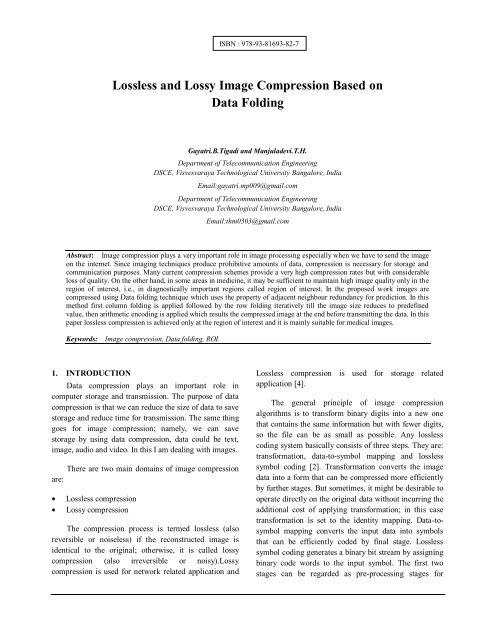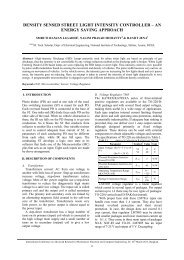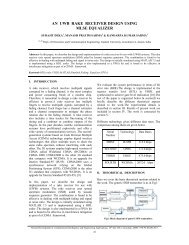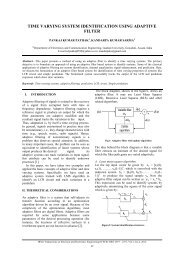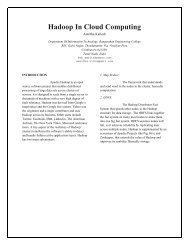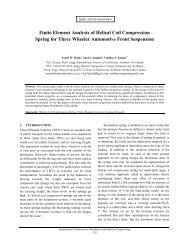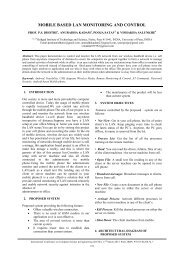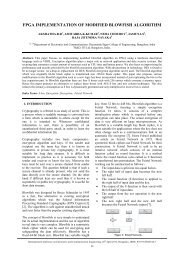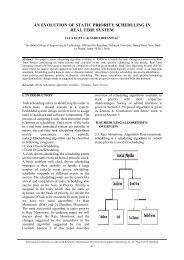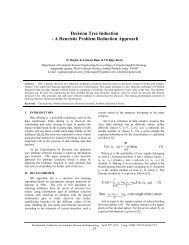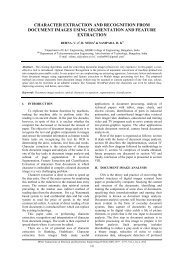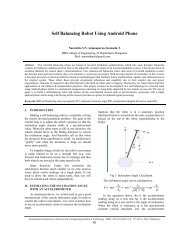Lossless and Lossy Image Compression Based on ... - IRNet Explore
Lossless and Lossy Image Compression Based on ... - IRNet Explore
Lossless and Lossy Image Compression Based on ... - IRNet Explore
You also want an ePaper? Increase the reach of your titles
YUMPU automatically turns print PDFs into web optimized ePapers that Google loves.
ISBN : 978-93-81693-82-7<br />
<str<strong>on</strong>g>Lossless</str<strong>on</strong>g> <str<strong>on</strong>g>and</str<strong>on</strong>g> <str<strong>on</strong>g>Lossy</str<strong>on</strong>g> <str<strong>on</strong>g>Image</str<strong>on</strong>g> <str<strong>on</strong>g>Compressi<strong>on</strong></str<strong>on</strong>g> <str<strong>on</strong>g>Based</str<strong>on</strong>g> <strong>on</strong><br />
Data Folding<br />
Gayatri.B.Tigadi <str<strong>on</strong>g>and</str<strong>on</strong>g> Manjuladevi.T.H.<br />
Department of Telecommunicati<strong>on</strong> Engineering<br />
DSCE, Visvesvaraya Technological University Bangalore, India<br />
Email:gayatri.mp009@gmail.com<br />
Department of Telecommunicati<strong>on</strong> Engineering<br />
DSCE, Visvesvaraya Technological University Bangalore, India<br />
Email:thm0303@gmail.com<br />
Abstract: <str<strong>on</strong>g>Image</str<strong>on</strong>g> compressi<strong>on</strong> plays a very important role in image processing especially when we have to send the image<br />
<strong>on</strong> the internet. Since imaging techniques produce prohibitive amounts of data, compressi<strong>on</strong> is necessary for storage <str<strong>on</strong>g>and</str<strong>on</strong>g><br />
communicati<strong>on</strong> purposes. Many current compressi<strong>on</strong> schemes provide a very high compressi<strong>on</strong> rates but with c<strong>on</strong>siderable<br />
loss of quality. On the other h<str<strong>on</strong>g>and</str<strong>on</strong>g>, in some areas in medicine, it may be sufficient to maintain high image quality <strong>on</strong>ly in the<br />
regi<strong>on</strong> of interest, i.e., in diagnostically important regi<strong>on</strong>s called regi<strong>on</strong> of interest. In the proposed work images are<br />
compressed using Data folding technique which uses the property of adjacent neighbour redundancy for predicti<strong>on</strong>. In this<br />
method first column folding is applied followed by the row folding iteratively till the image size reduces to predefined<br />
value, then arithmetic encoding is applied which results the compressed image at the end before transmitting the data. In this<br />
paper lossless compressi<strong>on</strong> is achieved <strong>on</strong>ly at the regi<strong>on</strong> of interest <str<strong>on</strong>g>and</str<strong>on</strong>g> it is mainly suitable for medical images.<br />
Keywords: <str<strong>on</strong>g>Image</str<strong>on</strong>g> compressi<strong>on</strong>, Data folding, ROI.<br />
1. INTRODUCTION<br />
Data compressi<strong>on</strong> plays an important role in<br />
computer storage <str<strong>on</strong>g>and</str<strong>on</strong>g> transmissi<strong>on</strong>. The purpose of data<br />
compressi<strong>on</strong> is that we can reduce the size of data to save<br />
storage <str<strong>on</strong>g>and</str<strong>on</strong>g> reduce time for transmissi<strong>on</strong>. The same thing<br />
goes for image compressi<strong>on</strong>; namely, we can save<br />
storage by using data compressi<strong>on</strong>, data could be text,<br />
image, audio <str<strong>on</strong>g>and</str<strong>on</strong>g> video. In this I am dealing with images.<br />
There are two main domains of image compressi<strong>on</strong><br />
are:<br />
<str<strong>on</strong>g>Lossless</str<strong>on</strong>g> compressi<strong>on</strong><br />
<str<strong>on</strong>g>Lossy</str<strong>on</strong>g> compressi<strong>on</strong><br />
The compressi<strong>on</strong> process is termed lossless (also<br />
reversible or noiseless) if the rec<strong>on</strong>structed image is<br />
identical to the original; otherwise, it is called lossy<br />
compressi<strong>on</strong> (also irreversible or noisy).<str<strong>on</strong>g>Lossy</str<strong>on</strong>g><br />
compressi<strong>on</strong> is used for network related applicati<strong>on</strong> <str<strong>on</strong>g>and</str<strong>on</strong>g><br />
<str<strong>on</strong>g>Lossless</str<strong>on</strong>g> compressi<strong>on</strong> is used for storage related<br />
applicati<strong>on</strong> [4].<br />
The general principle of image compressi<strong>on</strong><br />
algorithms is to transform binary digits into a new <strong>on</strong>e<br />
that c<strong>on</strong>tains the same informati<strong>on</strong> but with fewer digits,<br />
so the file can be as small as possible. Any lossless<br />
coding system basically c<strong>on</strong>sists of three steps. They are:<br />
transformati<strong>on</strong>, data-to-symbol mapping <str<strong>on</strong>g>and</str<strong>on</strong>g> lossless<br />
symbol coding [2]. Transformati<strong>on</strong> c<strong>on</strong>verts the image<br />
data into a form that can be compressed more efficiently<br />
by further stages. But sometimes, it might be desirable to<br />
operate directly <strong>on</strong> the original data without incurring the<br />
additi<strong>on</strong>al cost of applying transformati<strong>on</strong>; in this case<br />
transformati<strong>on</strong> is set to the identity mapping. Data-tosymbol<br />
mapping c<strong>on</strong>verts the input data into symbols<br />
that can be efficiently coded by final stage. <str<strong>on</strong>g>Lossless</str<strong>on</strong>g><br />
symbol coding generates a binary bit stream by assigning<br />
binary code words to the input symbol. The first two<br />
stages can be regarded as pre-processing stages for
<str<strong>on</strong>g>Lossless</str<strong>on</strong>g> <str<strong>on</strong>g>and</str<strong>on</strong>g> <str<strong>on</strong>g>Lossy</str<strong>on</strong>g> <str<strong>on</strong>g>Image</str<strong>on</strong>g> <str<strong>on</strong>g>Compressi<strong>on</strong></str<strong>on</strong>g> <str<strong>on</strong>g>Based</str<strong>on</strong>g> On Data Folding<br />
mapping the data into a form that can be coded more<br />
efficiently by the last stage.<br />
The efficient image compressi<strong>on</strong> algorithm or any<br />
data compressi<strong>on</strong> is chosen according to scales, such as<br />
compressi<strong>on</strong> size, compressi<strong>on</strong> ratio, compressi<strong>on</strong><br />
efficiency <str<strong>on</strong>g>and</str<strong>on</strong>g> computati<strong>on</strong>al complexity. The proposed<br />
method works fast for compressing the images which<br />
gives image compressi<strong>on</strong> with good compressi<strong>on</strong><br />
efficiency <str<strong>on</strong>g>and</str<strong>on</strong>g> low computati<strong>on</strong>al complexity. The<br />
remainder of this paper is organized as follows:<br />
pixel redundancies are rearranged in a tile format <str<strong>on</strong>g>and</str<strong>on</strong>g><br />
Arithmetic encoding technique is applied which results<br />
the compressed image at the end before transmitting the<br />
data. The idea is to reduce the image size iteratively in<br />
terms of dimensi<strong>on</strong>s - rows or columns by 2. At the<br />
decoder, Arithmetic decoding is applied followed by data<br />
unfolding which is similar to data folding. Difference<br />
data thus obtained through all iterati<strong>on</strong>s is stored in the<br />
tile format, as shown in Fig. 1.<br />
Secti<strong>on</strong> II describes the c<strong>on</strong>cept of regi<strong>on</strong> of interest.<br />
Secti<strong>on</strong> III describes the proposed method, Secti<strong>on</strong> IV<br />
experimental results, Secti<strong>on</strong> V c<strong>on</strong>clusi<strong>on</strong> <str<strong>on</strong>g>and</str<strong>on</strong>g> future<br />
scope followed by references.<br />
2. CONCEPT OF ROI<br />
A Regi<strong>on</strong> of Interest, often abbreviated ROI, is a<br />
selected subset of samples within a dataset identified for<br />
a particular purpose. The c<strong>on</strong>cept of an ROI is comm<strong>on</strong>ly<br />
used in medical imaging. Medical imaging has a great<br />
impact <strong>on</strong> medicine, especially in the fields of diagnosis<br />
<str<strong>on</strong>g>and</str<strong>on</strong>g> surgical planning [11]. However, imaging devices<br />
c<strong>on</strong>tinue to generate large amounts of data per patient,<br />
which require l<strong>on</strong>g-term storage <str<strong>on</strong>g>and</str<strong>on</strong>g> efficient<br />
transmissi<strong>on</strong>. Current compressi<strong>on</strong> schemes produce high<br />
compressi<strong>on</strong> rates if loss of quality is affordable. An<br />
approach that brings a high compressi<strong>on</strong> rate with good<br />
quality in the ROI is thus necessary. The general theme is<br />
to preserve quality in diagnostically critical regi<strong>on</strong>s while<br />
allowing lossy encoding of the other regi<strong>on</strong>s For<br />
example; the boundaries of a tumour may be defined <strong>on</strong><br />
an image or in a volume, for the purpose of measuring its<br />
size. So in case of ROI we separate the regi<strong>on</strong> of interest<br />
from the complete image in which the user is interested.<br />
3. PROPOSED METHOD<br />
In the proposed method the compressi<strong>on</strong> idea is<br />
based <strong>on</strong> spatial resoluti<strong>on</strong> for lossless image<br />
compressi<strong>on</strong> called corrugati<strong>on</strong>/ data folding [6, 7, 8, 9,<br />
10]. The idea is to subtract even pixels from odd pixels<br />
<str<strong>on</strong>g>and</str<strong>on</strong>g> store the difference data in a buffer. Odd pixels are<br />
stored in another buffer for further iterati<strong>on</strong>s. In this<br />
<str<strong>on</strong>g>Image</str<strong>on</strong>g> compressi<strong>on</strong> method first column folding is<br />
applied followed by the row folding iteratively till the<br />
image size reduces to predefined value. In column<br />
folding, pixels used for subtracti<strong>on</strong> are column adjacent<br />
whereas in row folding, the pixels are row adjacent. The<br />
Fig. 1: Difference data arranged in the tile format<br />
3.1 Encoder<br />
3.1.1 Data Folding<br />
Data folding is an iterative procedure, column<br />
folding followed by row folding, that is repeated at every<br />
image level. Original image (i.e. input image) must be<br />
square.<br />
Define a buffer „F‟ (also called image matrix) whose<br />
size is equal to that of original image. Original image is<br />
c<strong>on</strong>sidered as input image for the first iterati<strong>on</strong>. Initially,<br />
the buffer „F‟ is empty. In column folding, odd columns<br />
of the input image are subtracted from its right adjacent<br />
even columns <str<strong>on</strong>g>and</str<strong>on</strong>g> stored in first half columns of the<br />
empty porti<strong>on</strong> of the buffer „F‟. Odd columns are stored<br />
in a different buffer S‟ which is taken as input image to<br />
row folding. Following equati<strong>on</strong>s depicts column folding<br />
technique [1].<br />
F( X+a, Y+b ) = S( a, 2b-1 ) – ( a, 2b)<br />
S‟( a, b ) = S( a, 2b-1)
<str<strong>on</strong>g>Lossless</str<strong>on</strong>g> <str<strong>on</strong>g>and</str<strong>on</strong>g> <str<strong>on</strong>g>Lossy</str<strong>on</strong>g> <str<strong>on</strong>g>Image</str<strong>on</strong>g> <str<strong>on</strong>g>Compressi<strong>on</strong></str<strong>on</strong>g> <str<strong>on</strong>g>Based</str<strong>on</strong>g> On Data Folding<br />
a € [ 1, W] <str<strong>on</strong>g>and</str<strong>on</strong>g> b € [ 1, W/2]<br />
Where,<br />
S = input image<br />
W = width of input image<br />
S‟ = modified input image<br />
X = starting x-coordinate of empty porti<strong>on</strong> of „F‟<br />
Y = starting y-coordinate of empty porti<strong>on</strong> of „F‟<br />
Row folding is similar to column folding. In row<br />
folding, odd rows are subtracted from its adjacent even<br />
rows <str<strong>on</strong>g>and</str<strong>on</strong>g> stored in first half rows of empty porti<strong>on</strong> of „F‟.<br />
Odd rows are stored in a different buffer S‟‟ which is<br />
taken as input to next iterati<strong>on</strong>. Observe that, input image<br />
to column folding is always square whereas it is<br />
rectangular to row folding.<br />
3.1.2 Coding:<br />
This difference matrix can be entropy encoded by<br />
using various algorithms like Huffman Coding (HC),<br />
Arithmetic encoding (AC). I have encoded it using both<br />
Huffman algorithm <str<strong>on</strong>g>and</str<strong>on</strong>g> Arithmetic encoding <str<strong>on</strong>g>and</str<strong>on</strong>g><br />
compared both encoding techniques in each level of<br />
iterati<strong>on</strong>. The final result obtained after encoding the data<br />
of each level would be compressed data for the input<br />
image. The ratio of output compressed file to input image<br />
is the quantitative measure for the algorithm. The<br />
compressi<strong>on</strong> is measured as number of bits used per pixel<br />
<str<strong>on</strong>g>and</str<strong>on</strong>g> is calculated as input file size divided by sum of size<br />
of the output bit file (i.e. the matrix obtained after source<br />
encoding), sum of sizes of the dicti<strong>on</strong>aries <str<strong>on</strong>g>and</str<strong>on</strong>g> y bits (to<br />
send the iterati<strong>on</strong>s to the decoder) [7].<br />
Where,<br />
I = Raw image size (image size at start)<br />
I‟= Size of output bit file<br />
D= Sum of sizes of all dicti<strong>on</strong>aries<br />
y= no. of bits required to encode no. of iterati<strong>on</strong>s<br />
Fig 3: Illustrati<strong>on</strong> of data folding for the first iterati<strong>on</strong><br />
Fig 2: Flow chart of data folding<br />
3.2 Decoder<br />
The decoder will perform Arithmetic decoding<br />
followed by data unfolding. Data unfolding is an iterative<br />
procedure similar to data folding; row unfolding followed<br />
by column unfolding that is repeated at each image level.<br />
Here, no. of iterati<strong>on</strong>s is equal to that of data folding.<br />
Matrix elements which were folded in higher iterati<strong>on</strong>s<br />
during encoding will be unfolded first. Data folding starts<br />
with the first element of the image whereas data<br />
unfolding starts with bottom right elements of the image.
<str<strong>on</strong>g>Lossless</str<strong>on</strong>g> <str<strong>on</strong>g>and</str<strong>on</strong>g> <str<strong>on</strong>g>Lossy</str<strong>on</strong>g> <str<strong>on</strong>g>Image</str<strong>on</strong>g> <str<strong>on</strong>g>Compressi<strong>on</strong></str<strong>on</strong>g> <str<strong>on</strong>g>Based</str<strong>on</strong>g> On Data Folding<br />
The procedure is illustrated for a 16x16 image in<br />
Fig. 4. Assume that <strong>on</strong>ly 3 levels of folding is applied at<br />
the encoder side.<br />
Fig 6: Original image<br />
Fig 4: Flow chart of data Unfolding<br />
Fig. 5: Illustrati<strong>on</strong> of data unfolding algorithm<br />
4. EXPERIMENTAL RESULTS<br />
First Input image size is calculated based <strong>on</strong> number<br />
of rows <str<strong>on</strong>g>and</str<strong>on</strong>g> columns, then maximum possible iterati<strong>on</strong> is<br />
calculated using k= log2 (min value between rows <str<strong>on</strong>g>and</str<strong>on</strong>g><br />
column) = 8, after this encoding method is applied, which<br />
will give the following informati<strong>on</strong> of the image. Here I<br />
have compared results from both encoding techniques<br />
(i.e, Huffman <str<strong>on</strong>g>and</str<strong>on</strong>g> arithmetic encoding methods)<br />
Fig 7: Levels of folding<br />
Total bits of input image = 256*256*8 = 5, 24,288<br />
The maximum iterati<strong>on</strong> is 8<br />
Level = 4<br />
Total bits after Arithmetic compressi<strong>on</strong> = 65,821<br />
Total bits after Huffman compressi<strong>on</strong> = 93,633<br />
BPP = 1.428726<br />
The PSNR is 5.543254<br />
Fig 8: Extracted low frequency coefficients of fig 7
<str<strong>on</strong>g>Lossless</str<strong>on</strong>g> <str<strong>on</strong>g>and</str<strong>on</strong>g> <str<strong>on</strong>g>Lossy</str<strong>on</strong>g> <str<strong>on</strong>g>Image</str<strong>on</strong>g> <str<strong>on</strong>g>Compressi<strong>on</strong></str<strong>on</strong>g> <str<strong>on</strong>g>Based</str<strong>on</strong>g> On Data Folding<br />
Fig 9: Folded image<br />
Fig 12: Unfolded image (Rec<strong>on</strong>structed image)<br />
Total number of bits obtained after both Huffman<br />
<str<strong>on</strong>g>and</str<strong>on</strong>g> Arithmetic encoding techniques is as shown below<br />
for which input image chosen is cameramen.jpeg of<br />
resoluti<strong>on</strong> 256*256.<br />
Input image = 256*256*8 = 5, 24,288<br />
Table 1: Comparis<strong>on</strong> of total number of bits between<br />
Huffman <str<strong>on</strong>g>and</str<strong>on</strong>g> Arithmetic coding<br />
Fig 10: Levels of unfolding<br />
Level of<br />
iterati<strong>on</strong><br />
Total number of bits<br />
after compressi<strong>on</strong><br />
using Huffman<br />
coding<br />
Total number of bits<br />
after compressi<strong>on</strong><br />
using arithmetic<br />
coding<br />
1 263895 199969<br />
2 178591 156878<br />
3 153357 143086<br />
4 146128 139233<br />
5 144122 138269<br />
6 143604 138042<br />
7 143486 137996<br />
8 143461 137988<br />
Fig 11: Extracted low frequency coefficients of f ig 10<br />
5. CONCLUSION AND FUTURE SCOPE<br />
Data Folding is an algorithm for lossless image<br />
compressi<strong>on</strong> at the regi<strong>on</strong> of interest <str<strong>on</strong>g>and</str<strong>on</strong>g> lossy<br />
compressi<strong>on</strong> means quality of image degrades in the rest<br />
part of the image. It is simple <str<strong>on</strong>g>and</str<strong>on</strong>g> faster method which<br />
gives good bpp (bits per pixel) value, high PSNR <str<strong>on</strong>g>and</str<strong>on</strong>g><br />
lower computati<strong>on</strong>al complexity. Arithmetic coding is<br />
better than the Huffman coding because it gives fewer<br />
bits as level of folding increases. It works comparatively
<str<strong>on</strong>g>Lossless</str<strong>on</strong>g> <str<strong>on</strong>g>and</str<strong>on</strong>g> <str<strong>on</strong>g>Lossy</str<strong>on</strong>g> <str<strong>on</strong>g>Image</str<strong>on</strong>g> <str<strong>on</strong>g>Compressi<strong>on</strong></str<strong>on</strong>g> <str<strong>on</strong>g>Based</str<strong>on</strong>g> On Data Folding<br />
better for smooth images. The proposed work is mainly<br />
suitable for medical images.<br />
The proposed data folding algorithm can be<br />
implemented using transformati<strong>on</strong> technique such as<br />
DCT, DWT etc where the computati<strong>on</strong> complexity is<br />
affordable. This results high compressi<strong>on</strong> ratio <str<strong>on</strong>g>and</str<strong>on</strong>g><br />
achieves lossless compressi<strong>on</strong> for complete image.<br />
REFERENCES<br />
1. Suresh Yerva, Smita Nair, Krishnan Kutty,<br />
“<str<strong>on</strong>g>Lossless</str<strong>on</strong>g> <str<strong>on</strong>g>Image</str<strong>on</strong>g> <str<strong>on</strong>g>Compressi<strong>on</strong></str<strong>on</strong>g> based <strong>on</strong> Data<br />
Folding”, IEEE-Internati<strong>on</strong>al C<strong>on</strong>ference <strong>on</strong> Recent<br />
Trends in Informati<strong>on</strong> Technology, ICRTIT 2011.<br />
2. Alan C<strong>on</strong>rad Bovik, The Essential guide to <str<strong>on</strong>g>Image</str<strong>on</strong>g><br />
Processing, vol. 16, pp. 385-419, 2009.<br />
3. Marcelo J. Weinberger, Senior Member, IEEE,<br />
Gadiel Seroussi, Fellow, IEEE, <str<strong>on</strong>g>and</str<strong>on</strong>g> Guillermo<br />
Sapiro, Member, IEEE “The LOCO-I <str<strong>on</strong>g>Lossless</str<strong>on</strong>g> <str<strong>on</strong>g>Image</str<strong>on</strong>g><br />
<str<strong>on</strong>g>Compressi<strong>on</strong></str<strong>on</strong>g> Algorithm:Principles <str<strong>on</strong>g>and</str<strong>on</strong>g><br />
St<str<strong>on</strong>g>and</str<strong>on</strong>g>ardizati<strong>on</strong> into JPEG-LS”, VOL.9, NO. 8,<br />
AUGUST 2000.<br />
4. R.Sudhakar,Ms R Karthiga, S.Jayaraman, “Wavelet<br />
<str<strong>on</strong>g>Based</str<strong>on</strong>g> <str<strong>on</strong>g>Image</str<strong>on</strong>g> <str<strong>on</strong>g>Compressi<strong>on</strong></str<strong>on</strong>g> using SPIHT algorithm”<br />
ICGST-GVIP Journal, Volume (5), Issue(6), June<br />
2005.<br />
5. Amir Said, Member, IEEE, <str<strong>on</strong>g>and</str<strong>on</strong>g> William A.<br />
Pearlman, Senior Member, IEEE, “An <str<strong>on</strong>g>Image</str<strong>on</strong>g><br />
Multiresoluti<strong>on</strong> Representati<strong>on</strong> for <str<strong>on</strong>g>Lossless</str<strong>on</strong>g> <str<strong>on</strong>g>and</str<strong>on</strong>g><br />
<str<strong>on</strong>g>Lossy</str<strong>on</strong>g> <str<strong>on</strong>g>Compressi<strong>on</strong></str<strong>on</strong>g>”, VOL. 5, NO. 9, SEPTEMBER<br />
1996.<br />
6. Bin Zhu, Mitchell D. Swans<strong>on</strong>, <str<strong>on</strong>g>and</str<strong>on</strong>g> Ahmed H.<br />
Tewfik, “<str<strong>on</strong>g>Image</str<strong>on</strong>g> Coding by Folding”, 1997 IEEE.<br />
7. Alan C<strong>on</strong>rad Bovik, The Essential guide to <str<strong>on</strong>g>Image</str<strong>on</strong>g><br />
Processing, vol. 16,pp. 385-419, 2009.<br />
8. Chin-Chen Chang, *Chi-Shiang Chan <str<strong>on</strong>g>and</str<strong>on</strong>g> **Ju-<br />
Yuan Hsiao “<str<strong>on</strong>g>Lossless</str<strong>on</strong>g> <str<strong>on</strong>g>Image</str<strong>on</strong>g> <str<strong>on</strong>g>Compressi<strong>on</strong></str<strong>on</strong>g> <str<strong>on</strong>g>Based</str<strong>on</strong>g> <strong>on</strong><br />
Two-Way Smaller Difference”, 2003 IEEE.<br />
9. Michael Ciavarella Alistair Moffat ,”<str<strong>on</strong>g>Lossless</str<strong>on</strong>g> <str<strong>on</strong>g>Image</str<strong>on</strong>g><br />
<str<strong>on</strong>g>Compressi<strong>on</strong></str<strong>on</strong>g> Using Pixel Reordering” Department<br />
of Computer Science <str<strong>on</strong>g>and</str<strong>on</strong>g> Software Engineering The<br />
University of Melbourne, Australi<br />
10. Bruno carpentieri, member, IEEE, Marcelo j.<br />
Weinberger, senior member, IEEE, <str<strong>on</strong>g>and</str<strong>on</strong>g> Gadiel<br />
seroussi, fellow, IEEE, “lossless compressi<strong>on</strong> of<br />
c<strong>on</strong>tinuous-t<strong>on</strong>e images”, proceedings of the<br />
IEEE, vol. 88, no. 11, November 2000.<br />
11. Yair Wiseman, “Burrows-Wheeler <str<strong>on</strong>g>Based</str<strong>on</strong>g> Jpeg”,<br />
Data Science Journal, Volume 6, 5 March 2007.<br />
12. Balpreet Kaur, Deepak Aggarwal, Gurpreet Kaur,<br />
Am<str<strong>on</strong>g>and</str<strong>on</strong>g>eep Kaur, “Efficient <str<strong>on</strong>g>Image</str<strong>on</strong>g> <str<strong>on</strong>g>Compressi<strong>on</strong></str<strong>on</strong>g><br />
based <strong>on</strong> Regi<strong>on</strong> of Interest”, IJCSt vol . 2, issue 1,<br />
march 2011.


